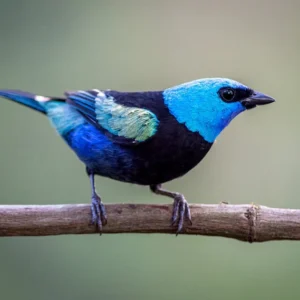Description
Tanger Blue Dacnis
Small active warblerlike tanager with sharply pointed bill. Male blue with thin black mask, black throat and back. Female also distinctive, body entirely lime green with mostly blue head. Usually seen in pairs or small groups in the canopy of lowland and foothill forests, edges, and secondary growth. Often follows mixed feeding flocks. Feeds on fruit.
The blue dacnis or turquoise honeycreeper (Dacnis cayana) is a small passerine bird. This member of the tanager family is found from Nicaragua to Panama, on Trinidad, and in South America south to Bolivia and northern Argentina. It is widespread and often common, especially in parts of its South American range.
In 1760, the French zoologist Mathurin Jacques Brisson included a description of the blue dacnis in his Ornithologie based on a specimen collected in Cayenne in French Guiana. He used the French name Le Pepit bleu de Cayenne and the Latin name Sylvia cayanensis caerulea. Although Brisson coined Latin names, these do not conform to the binomial system and are not recognised by the International Commission on Zoological Nomenclature. When in 1766 the Swedish naturalist Carl Linnaeus updated his Systema Naturae for the twelfth edition he added 240 species that had been previously described by Brisson. One of these was the blue dacnis. Linnaeus included a terse description, coined the binomial name Motacilla cayana and cited Brisson’s work. The specific name cayana is from Cayenne.[5] This species is now placed in the genus Dacnis that was introduced in 1816 by the French naturalist Georges Cuvier with the blue dacnis as the type species.
The blue dacnis is 12.7 cm long and weighs 13 g. Despite its alternative name, it is not a honeycreeper, which are longer-billed. The adult male is turquoise blue with a black around the eyes, and on the throat and back. The wings and tail are black, edged with turquoise. The female and immature are mainly green with a blue head, paler green underparts and green-edged brown wings. The blue dacnis’s call is a thin tsip.













